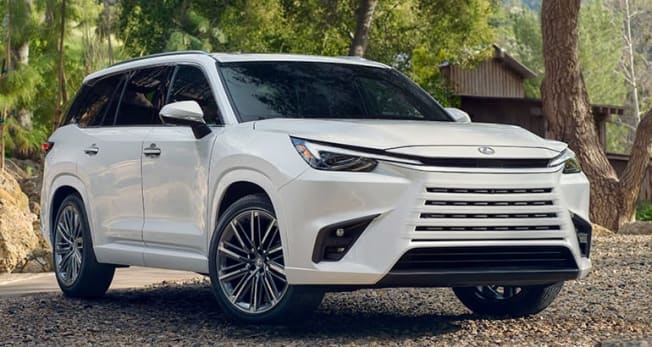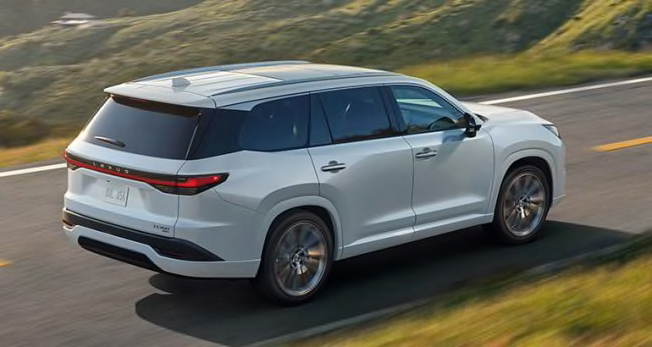Preview: All-New, Three-Row 2024 Lexus TX SUV Available as a Powerful Hybrid
Modern luxury for the whole family

By Jeff S. Bartlett
Lexus is expanding its SUV line with the all-new TX, a three-row model that shares its dimensions and many mechanical bits with the new Toyota Grand Highlander. Sized a notch up from the recently redesigned RX, the TX pulls together many established Lexus elements, from the turbo and hybrid powertrains to the large infotainment screen with integrated knobs.
Where the redesigned GX and LX aim for those towing a heavy load or traversing off the beaten path, the TX is focused on refined road manners. It has a much more spacious interior than the RX, with all the features one would expect from a premium SUV.
The Lexus TX has a three-powertrain strategy, with its top offering being a powerful plug-in hybrid with over 400 horsepower and 33 miles of electric-only range.
The TX will be offered in four trims: Standard, Premium, Luxury, and F Sport Performance.
It will be the first Lexus manufactured at Toyota’s assembly plant in Indiana. The model range kicks off in fall 2023 with the base TX 350 and mid-level 500h. The 550h+ plug-in hybrid will join at a later date.
Here is what we know so far:
What it competes with: Acura MDX, Audi Q7, BMW X7, Cadillac XT6, Infiniti QX60, Jeep Grand Cherokee L, Lincoln Aviator, Mazda CX-90, Toyota Grand Highlander
Powertrains:
• 275-hp, 2.4-liter turbocharged four-cylinder; eight-speed automatic transmission; front- or all-wheel drive.
• 366-hp, 2.4-liter turbocharged four-cylinder hybrid; six-speed automatic transmission; all-wheel drive.
• 406-hp, 3.5-liter V6 plug-in hybrid; continuously variable transmission; all-wheel drive.
Price: $50,000-$70,000 (estimated)
On sale: Fall 2023
CR's Take
Consider the TX to be a grander Toyota Grand Highlander. It is another example of how Toyota is able to mix and match platforms, powertrains, and other components from its extensive parts bin. The automaker has taken this to extremes lately, creating a dizzying array of choices for car buyers. Here, with the Lexus TX, there are four trims, three powertrains, and a handful of options.
This fits well in the lineup, serving as a step-up model from the RX (or essentially a successor to the previous generation RX-L, a three-row, last-generation RX) for buyers who want more interior space for a growing family. The RX-L was a sound idea, but the execution came across like the afterthought that it was. Space was tight, and it just didn’t fulfill the mission. The TX promises to be a true three-row model with room for adults in the rear.
As wild as the design is for the latest GX, we’re glad to see a tamer approach with the TX. It is a very straightforward design, augmented by promising powertrains and welcomed features.

The exterior is rather tasteful and timeless, with a restrained interpretation of the modern Lexus grille.
Photo: Lexus
Outside
Sized like the Grand Highlander, and stretching 10 inches longer than an RX, the TX wears rather clean sheetmetal, without an extroverted appearance like the upcoming Lexus GX. Most notable, the front spindle grille is more restrained than that seen on past Lexus models, where at times it resembled the sci-fi movie Predator’s maw. The headlights are slim and tidy, flowing right into a horizontal design element ahead of the hood. But their angle gives the TX an angry visage.
The sides are clean, with wheel arch lines stamped in the fenders and unadorned by plastic flares like many other competing models. The little jog line for the rear side glass reminds of the Kia Sedona minivan. That rear pillar is blackened, creating the floating roof design that has become de rigueur.
Overall, the appearance is upscale and classy. It should look right at home alongside competitors like the Acura MDX and Infiniti QX60.

The cabin looks much like any other recent Lexus SUV, with a large screen with integrated graphic-filled knobs and physical controls for key functions.
Photo: Lexus
Inside
The TX dash reminds of other recent models, featuring a 12.3-inch digital instrument display and a large 14-inch center infotainment screen. The Lexus trend of using knobs with integrated screens for adjusting the climate temperature is truly a neat bit of engineering. There are physical controls for key functions, like adjusting volume, warming our little hearts. A head-up display is available, putting essential information close to the driver’s sight line. But as with other Lexus models, it appears to be paired with unlabeled steering wheel controls, which we have found tedious and distracting to use on other models. A 21-speaker Mark Levinson stereo is an optional upgrade.
The USB charge points are easily accessible and clearly labeled. Small touches like that make a difference in daily living. There are seven charge ports total throughout the cabin.
Another interesting detail: Some cupholders are removable so those storage nooks can be used in different ways.
The second row can be configured with a 60/40-split bench seat or with two captain’s chairs. Either way, the seats can slide forward to ease access to the third row. There is a separate control to allow the aft passengers to move the second-row seats forward to aid their egress.
Like the Grand Highlander, a key premise for the TX is an adult-friendly third-row and usable rear cargo space, even with the seat up.
As with other recent Lexus models, the TX has electronic door releases. We have mixed feelings about these light-touch releases, which tend to move in a less-natural way than a mechanical release and can puzzle passengers who are unfamiliar with their operation.

The restrained design adapts the floating roof design, an illusion crafted with a black rear pillar, seen on the RX and other models.
Photo: Lexus
What Drives It
Lexus has been generous with powertrains lately, providing more options than one could rightfully expect. First it was the NX, then the RX, and now the TX—each with three or more choices.
The TX 350 comes with a 2.4-liter turbocharged four-cylinder that produces 275 horsepower. It is paired with an eight-speed automatic transmission, and it will be offered in front- or all-wheel drive. Lexus estimates fuel economy to be 21 mpg combined.
Then there is a giant leap to the mid-level powertrain in the TX 500h, a 366-hp, 2.4-liter turbocharged four-cylinder hybrid with a six-speed automatic transmission. This mighty hybrid comes in just an all-wheel drive configuration. The estimated fuel economy is 24 mpg combined.
Joining the TX line at a later date is the 550h+ plug-in hybrid in all-wheel drive. This centers around a 3.5-liter V6 with a continuously variable transmission. Total output is 406 horsepower. The automaker projects 30 mpg combined, with 33 miles of electric-only range.
Active Safety and Driver Assistance
Lexus Safety System+ 3.0 is standard on the TX, bundling a full suite of active safety and convenience features. These include automatic emergency braking with pedestrian detection, lane departure warning, lane centering assistance, adaptive cruise control, automatic high beams, and road sign assist. Proactive Driving Assist provides light braking and steering assistance when entering turns, and help for reacting to other vehicles, cyclists, and pedestrians. There is a rear seat reminder to help ensure little ones and pets are not left behind.
Available parking assist automates pulling into a parallel or perpendicular parking space.
Consumer Reports is an independent, nonprofit organization that works side by side with consumers to create a fairer, safer, and healthier world. CR does not endorse products or services, and does not accept advertising. Copyright © 2023, Consumer Reports, Inc.
